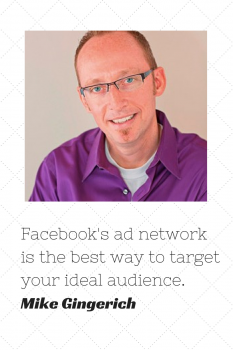Podcast: Play in new window | Download
Subscribe: RSS

This is Episode 7 of This Old New Business weekly business podcast with Jeff Korhan.
I have to be honest. I have not been a big fan of Facebook for marketing my business. However, this conversation with Mike Gingerich changed my thinking, and it just may do the same for you.
Mike genuinely likes to help people, so listen in as he share’s a wealth of information that will help you better understand Facebook, including how it differs from Google+, why Facebook does some of the crazy things they do, how to get more engagement on Facebook, and how to use Facebook’s ad network to hit your ideal target audience.
Plus, you’ll learn a few tips for integrating Facebook marketing into an overall digital marketing strategy.
Our Featured Guest: Mike Gingerich
 Mike Gingerich is best known as the co-founder of Tabsite, a leading Facebook Page app platform for contests and lead capture. He is also a Facebook marketing speaker, strategist, and writer for notable business publications.
Mike Gingerich is best known as the co-founder of Tabsite, a leading Facebook Page app platform for contests and lead capture. He is also a Facebook marketing speaker, strategist, and writer for notable business publications.
Mike hails from the Hoosier heartland of Indiana, and therefore is naturally an avid basketball fan. His small business digital podcast is appropriately named Halftime Mike.
Facebook Demographics are One of a Kind
When the Facebook Like feature was released in early 2010, many of us got excited about it’s possibilities. We realized Facebook was gathering rich, contextual data that businesses could use to attract and engage their ideal audience.
That reality still exists, except we have to work a little harder to leverage it’s possibilities. The good news is that the demographics of Facebook are like no other. As we discussed how Facebook compares to Google+ and the other social networks, Mike notes that unlike the others, every demographic is represented on Facebook, with the 50+ age group being the strongest.
The majority of businesses are targeting people between the ages of 20 and 60, and you can find them all actively engaging on Facebook.
How to Increase Engagement on Facebook
Like so many other things digital, Facebook is an ongoing experiment for businesses these days. Mike suggests starting with Facebook Insights on your business page to learn when your audience is most active online. Then experiment with a variety of posts (photo post, text only post, link post, etc) to learn what favorably moves the needle.
Mike’s Facebook strategy is dedicating 50% of his Facebook content to either solving problems or entertaining. Yes, it is true that for the most part Facebook is for showing off. The idea behind this approach is sharing relevant content that builds likeabilty and trust. In other words, attraction and engagement create the potential for capturing leads.
If you devote half of your efforts to attraction and engagement, they will be there for you when you make your business offers.
Facebook Advertising Explained
If you are not getting results with Facebook advertising it may be that you do not clearly know who you are targeting. There is no question that Facebook’s ad network is a great way to hit your target audience, but only if you can define that audience well.
It should not come as a surprise that Facebook wants you to advertise, so they offer different means for accomplishing this. If you want easy, then boosting a post is for you. There is also the Facebook Ads Manger and the browser based Power Editor.
As the name implies, the Power Editor is for those that want access to the latest and most powerful features. You can find it here and learn how to use it here.
Lighting Round Tips and Advice
Mike’s Top Sales or Marketing Advice – Know your ideal audience and speak directly to them in your messaging.
His Favorite Productivity Tip – Use Feedly and Buffer for consuming and sharing content. Learn more social media efficiency tips from Mike here.
A Quote that has Inspired Mike’s Success – “Be distinct. The alternative is extinct.” Tom Peters and Robert Waterman, authors of In Search of Excellence
Key Take-Aways
- The Facebook ad network is by far the best way to hit your ideal target audience, provided you know who that audience is.
- You have to experiment with post types and Facebook ads to attract your audience and keep them engaged.
- Here is the link to the 3 Key Elements of a Digital Marketing Strategy post that Mike mentioned.
- Join Mike and leading social media experts next week for the online Doable Social Summit. Use code jeffkorhan and save $97 on your registration! Valid for regular or VIP pass.
- You can find Mike online at MikeGingrich.com and on Facebook.
- Check out The Halftime Mike Podcast Show .
- Learn more about the Tabsite Facebook Platform
How to subscribe to This Old New Business podcast
Click here to subscribe via iTunes.
You can also subscribe via Stitcher.
Help us Spread the Word
Please let your Twitter followers know about this podcast. One click on this ready-made tweet will make that super easy.
If you enjoyed this episode of This Old New Marketing podcast, please head over to iTunes to leave a rating, write a review, or subscribe. If you use Stitcher, click here to leave a rating, write a review, and subscribe.
How is your business using Facebook marketing to attract your ideal audience?
About the Author: Jeff Korhan, MBA, is the author of Built-In Social: Essential Social Marketing Practices for Every Small Business and host of This Old New Business podcast.
He helps mainstream businesses adapt their traditional growth practices to a digital world. Connect with Jeff on LinkedIn, Twitter, Facebook, and Google+



